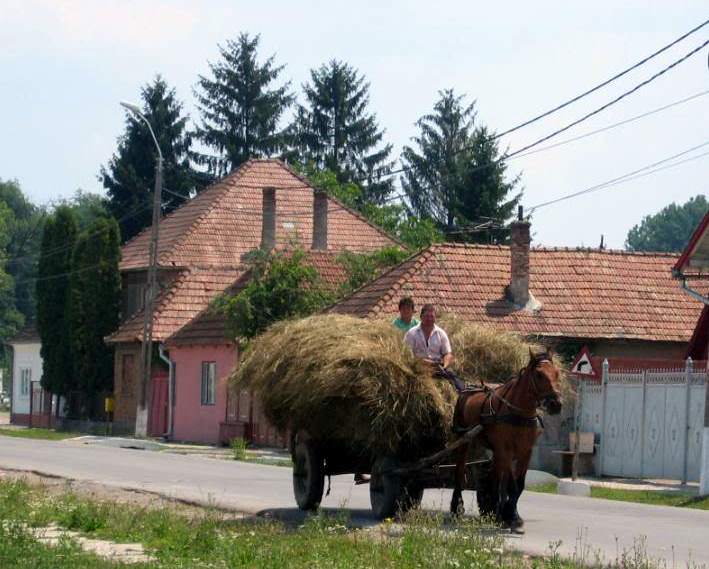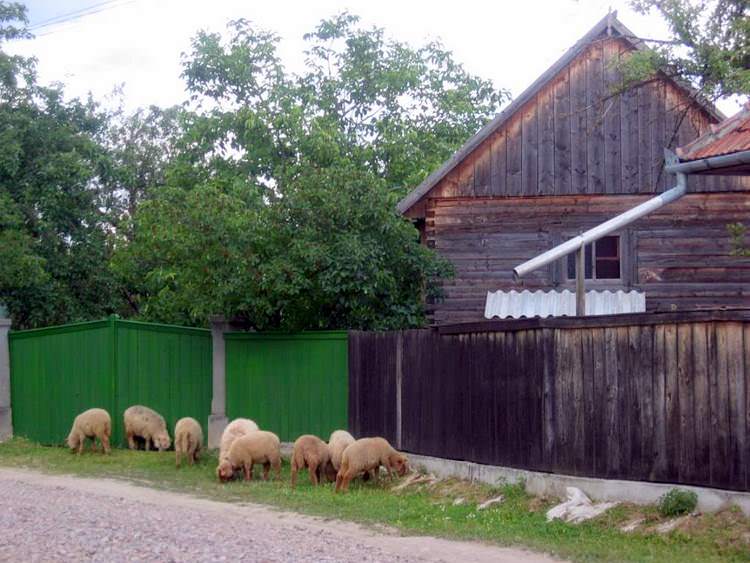The Szekely area of Romania is unique and unpredictable, in terms of both its population and its natural environment. It’s the most densely populated Hungarian-speaking part of the Transylvania region, despite being the furthest away from today’s Hungary. It’s also a volcanic area full of springs, bubbling mud, and mineral deposits.

The Szekelys are a people who were sent in the 13th century to defend what was then Hungary’s eastern frontier. Today they number about 670,000, spread across the counties known (in Romanian and in Hungarian) as Harghita/Hargita, Covasna/Kovaszna and Mures/Maros. They remain a rural people, living in lands that are under deep snow in winter, when cold air gets trapped among the mountains. Many live from production of timber, maize, potatoes, beverages and garments, or from mining. They frequently travel by horse cart, and keep sheep and geese that freely graze around the villages. Wilder denizens of the area include wolves, bears, stags and lynx.
A famous feature of Szekely houses is a carved wood gate with two sections, one big enough for a horse cart and one for people to walk through. The gates are then topped  with a narrow roof. To this day these gates continue to be produced, while some have remained in use from as far back as the 18th century. They are carved or painted in decorative patterns featuring geometric shapes, moons, stars, tulips – ancient Szekely symbols. Sometimes there’s a dovecot on top. In some localities, Szekelys make pottery, woven garments, wickerwork and painted wooden furniture, including colourful dowry chests, in the time-honored fashion.
with a narrow roof. To this day these gates continue to be produced, while some have remained in use from as far back as the 18th century. They are carved or painted in decorative patterns featuring geometric shapes, moons, stars, tulips – ancient Szekely symbols. Sometimes there’s a dovecot on top. In some localities, Szekelys make pottery, woven garments, wickerwork and painted wooden furniture, including colourful dowry chests, in the time-honored fashion.
A good place to see such things is the two-hectare ethnographic museum in Cernatu de Jos/Alsocsernaton, established in 1973. Here you can also see wooden pillars used as grave markers with carved geometric forms conveying information on the deceased person.
The Szekely land is home to arguably Romania’s best beer, the smooth, light, fruity Ciuc. It also boasts fine mineral waters, including mild-tasting Borsec,  famous since medieval times. It is rich in magnesium, calcium and sodium, as well as the rather salty Harghita. In addition, Szekelys make great palinka, a strong spirit cooked from fruit. The town of Zetea/Zetelaka is widely revered for its production of this tipple.
famous since medieval times. It is rich in magnesium, calcium and sodium, as well as the rather salty Harghita. In addition, Szekelys make great palinka, a strong spirit cooked from fruit. The town of Zetea/Zetelaka is widely revered for its production of this tipple.
There is not really a Szekely capital, because when a city gets too large, it loses that Szekely atmosphere. Targu Mures/Marosvasarhely (pop. 145,000) lost the title long ago, and even the old market town of Miercurea Ciuc/Csikszereda (42,000) is being challenged now by Odorheiu Secuiesc/Székelyudvarhely (37,000).
Even in a populated town, you’re never far from the wild outdoors. On the main square of the town of Covasna is a bubbling patch of soil called “Hell’s mud.” This town is called “town of 1,000 springs,” but that estimate is rather conservative. The town of Sovata/Szovata has grown up as a health tourism center based on the salty, bearskin-shaped Lacul Ursu/Medve-to (“bear lake”), probably the world’s largest heliothermic lake. That means its great warmth stems from solar energy trapped within its differing layers: a few feet of fresh water on top, insulating the lower layers that are heavy with salt, magnesium and calcium.
 No one is sure where the Szekelys came from and whether they share an origin with the regular Hungarians or Magyars. Starting in the 15th century, Transylvania had a caste system in which Szekelys, along with Magyars and Germans, were the “Three Nations,” but this implied less an ethnic than a functional division. The Szekelys’ function was to be warriors.
No one is sure where the Szekelys came from and whether they share an origin with the regular Hungarians or Magyars. Starting in the 15th century, Transylvania had a caste system in which Szekelys, along with Magyars and Germans, were the “Three Nations,” but this implied less an ethnic than a functional division. The Szekelys’ function was to be warriors.
Deeply rooted to their homes today, Szekelys used to be extremely mobile. They lived all over Transylvania before settling in their present haunts, moving ever eastward to defend Hungary’s border as it expanded. Three of the administrative regions or “seats” they formed – Kezdi, Orbai and Sepsi – were named after places further west where they were previously based.
In some ways, the Szekelys are the most Hungarian of Hungarians. In the north of their area at least, they remain predominantly Catholic while many Transylvanian Hungarians have converted to Calvinism or Unitarianism. They speak with antiquated accents, which even vary from  one part of the Szekely land to another. They were slow to adopt the Latin alphabet in place of the traditional Hungarian runes. A famous runic panel on the ceiling of the church in Inlaceni/Enlaka bears the name of its craftsman, Gyorgy Muzsnai.
one part of the Szekely land to another. They were slow to adopt the Latin alphabet in place of the traditional Hungarian runes. A famous runic panel on the ceiling of the church in Inlaceni/Enlaka bears the name of its craftsman, Gyorgy Muzsnai.
Szekelys were loyal subjects of the old kingdom of Hungary, building fortified towns to defend against invasions by Tatars and the like. From the middle of the 16th century, though, they were less acquiescent subjects of an independent Transylvania ruled by Magyar aristocrats. They started having to pay taxes, faced limits on their autonomy, and fought a battle in 1567 to prevent being converted to Protestantism. That event has been commemorated every year since then, with a Whitsun pilgrimage to Sumuleu Ciuc/Csiksomlyo. Today, attracting up to 400,000 people from across Europe, it culminates with an open-air mass.
In 1599, the Szekelys went so far as to ally with Mihai Viteazul, a Wallachian prince, who for one year held Transylvania. Effectively, they were supporting Mihai’s allies, the Austrians, against the Transylvanian leaders and their Ottoman allies. This conflict led to the oddity of the Szekelytamadt (“Szekely-attacked”) fortress in Odorheiu Secuiesc. First erected in 1492 to protect locals, its reinforcement by the prince of Transylvania during the 1560s was more intended to keep the Szekelys in check. The fortress was attacked in 1599 by the town’s inhabitants working together with Mihai’s forces.
The area later joined the Habsburg empire, at which point many towns were rapidly built up and renovated. That accounts for today’s proliferation of Baroque urban architecture. But in the later 18th century, Szekelys faced off against Habsburg attempts to make the empire’s  provinces more uniform. Their devastating defeat at the hands of imperial forces at Ciceu/Csikcsicso in 1764 remains part of the Szekelys’ folklore. It prompted some to migrate eastward to Moldavia: the legendary csango or “wanderer” people.
provinces more uniform. Their devastating defeat at the hands of imperial forces at Ciceu/Csikcsicso in 1764 remains part of the Szekelys’ folklore. It prompted some to migrate eastward to Moldavia: the legendary csango or “wanderer” people.
The Szekelys now live well within the post-World War I borders of Romania, although during World War II they briefly rejoined a sovereign Hungary for the first time in three-and-half centuries, when their lands were included in a slice of northern Transylvania attached to that country. Since the fall of communism, some Szekelys have moved to modern-day Hungary, where they work in factories and send money home. But they are sometimes received superciliously there, like country cousins. There’s a joke that relocating to Budapest is the fastest way for a Szekely to turn into a Romanian.
For a great place to stay in Szekely land, look no further than Zabala/Zabola, where a 17th-19th century aristocratic castle with a 16-hectare landscaped garden has been returned to its dynasty after decades of nationalization. The family converted it into a delightful hotel that meets the highest international standards.
Written by David Hill for EuropeUpClose.com

Jimmy
Wednesday 28th of September 2011
Good to hear from our homeland. If you like to be part of our 'szekelyland monument' than let us know at:
Attila
Saturday 16th of July 2011
Hello. It has been interesting to find an article about our homeland. We enjoyed your article about Székelyföld as we are székely web developers.
If anybody is interested to find out more about Székelyföld and its curiosities please feel free to visit the webpage of the Puturosu Mountain.
Thanks for writing about our culture. The waaab crew
Charlie Sekely Gavel
Thursday 5th of July 2012
Thank you, as our Grandfather came from the old country, our name was changed to Sekely. I grew up always wanting to know more but they were fearful of talking about where they came from.finding out all this information is amazing.My olderbrother was in Germany and went there to see where it was, He said he was welcomed with open arms...He loved the countryside.
Mihai
Sunday 26th of December 2010
it was less of a travel report and more of a history lesson, which is fine, but I think more details about the actual place -the people, the customs, the houses, the landscapes- would have been better.
Pankaj Sharma
Thursday 23rd of December 2010
Szekely is a heaven.I would definitely like to visit this place once in a life.The way you have written the article is great.I liked the firt pic most.:) Keep good work going on .:)
John
Wednesday 22nd of December 2010
Nice post with excellent pictures. The pictures alone would make me want to go there, because they show how much character the place has!